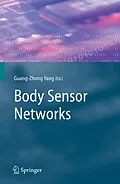The last decade has witnessed a rapid surge of interest in new sensing and monitoring devices for healthcare. One key development in this area is wireless wearable and implantable in vivo monitoring and intervention devices. While the problems of long-term stability and biocompatibility are being addressed, several promising prototypes are starting to emerge for managing patients with acute diabetes, for treatment of epilepsy and other debilitating neurological disorders and for monitoring of patients with chronic cardiac diseases. Despite the technological developments in sensing and monitoring devices, issues related to system integration, sensor miniaturization, low-power sensor interface circuitry design, wireless telemetric links and signal processing still have to be investigated. This book addresses the general issues related to the rapidly changing field of Body Sensor Networks (BSN) and discusses the latest technological developments and potential clinical applications.
Key contents of the book include:
- Biosensor Design, Interfacing and Protein Engineering
- Wireless Communication and Network Topologies
- Communication Protocols and Standards
- Energy Scavenging
- Ultra-Low Power Bio-inspired Processing
- Multi-sensor Fusion and Context-aware Sensing
- Autonomic Sensing
- System Integration and Wireless sensor Microsystem Design
The book also provides a comprehensive review of current wireless sensor development platforms and a step-by-step guide to developing your own BSN applications through the use of the BSN Development Kit. Online materials and the latest updates for the BSN Development Kit are available from http://www.bsn-web.info.
Zusammenfassung
Advances in science and medicine are closely linked; they are characterised by episodic imaginative leaps, often with dramatic effects on mankind and beyond. The advent of body sensor networks represents such a leap. The reason for this stems from the fact that all branches of modern medicine, ranging from prevention to complex intervention, rely heavily on early, accurate, and complete diagnosis followed by close monitoring of the results. To date, attempts at doing this consisted of intermittent contact with the individual concerned, producing a series of snapshots at personal, biochemical, mechanical, cellular, or molecular levels. This was followed by making a series of assumptions which inevitably resulted in a distortion of the real picture. Although the human genome project has shown that we are all equal, it confirmed the fact that each one of us has unique features at many levels, some of which include our susceptibility to disease and a particular response to many external stimuli, medicines, or procedures. This has resulted in the concept of personalised medicines or procedures promised to revolutionise our approach to healthcare. To achieve this, we need accurate individualised information obtained at many levels in a continuous fashion. This needs to be accomplished in a sensitive, respectful, non-invasive manner which does not interfere with human dignity or quality of life, and more importantly it must be affordable and cost-effective.
Inhalt
Biosensor Design and Interfacing.- Protein Engineering for Biosensors.- Wireless Communication.- Network Topologies, Communication Protocols, and Standards.- Energy Scavenging.- Towards Ultra-Low Power Bio-Inspired Processing.- Multi-Sensor Fusion.- Context-Aware Sensing.- Autonomic Sensing.- Wireless Sensor Microsystem Design: A Practical Perspective.- Conclusions and Future Outlook.
